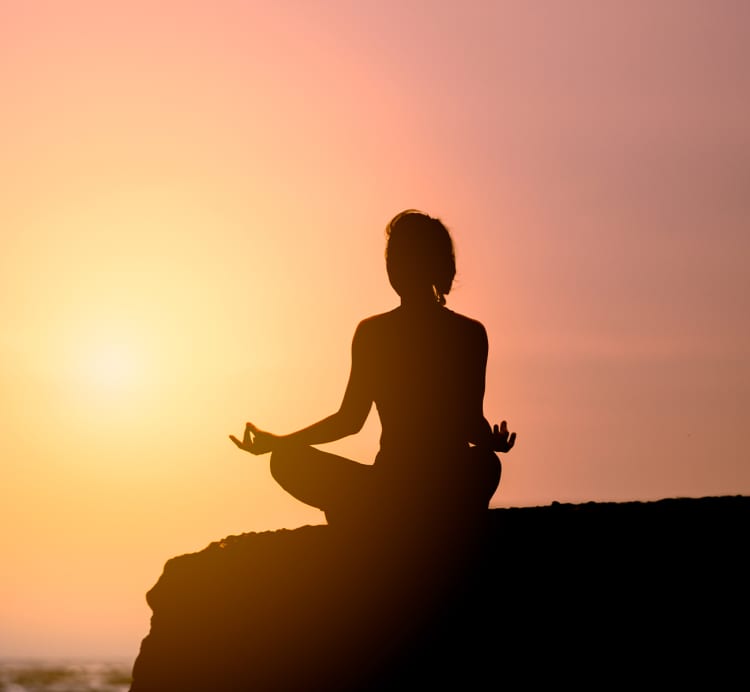Yoga Nidra
Yoga Nidra is a very powerful meditation practice that helps people feel relaxed and peaceful. Anyone can practice yoga Nidra. It begins from the corpse pose or savasana and takes the practitioner through the Pancha Maya Kosh, five layers of self. It imparts a feeling or sense of completeness or wholeness to the individual. The regular practice of Yoga Nidra has been found to have immense benefits to people that manifest in several ways.
Know more
Yoga Nidra
Yoga Nidra is a time-honored technique where one enters a deep state of conscious relaxation. This practice enables the physical, mental, and emotional being to align in a harmonious tranquility. These audio-led sessions by Divya Rolla will have a profound impact on the body and mind, and can be performed by those recovering from COVID-19.
Benefits:
- Improves sleep quality
- Reduces Insomnia
- Aids in connecting with self
Yoga Nidra Series-1
Yoga Nidra is one of the pre meditative practices. Practiced in Shavasana, the mind is trained to dwell in between sleep and wakefulness.
Yoga Nidra Series -2
This series will explore a new visualisation method called Recollection. In a state of relaxed and balanced mind, spending some time recollecting the events of the day or past will help not to carry forward stress into the next day. A small thing that can go a long way if practiced regularly!
Yoga Nidra Series -3
This practice explores a technique called Pair of Opposites. In this, one will relive a body sensation and all of a sudden let go of it to pick up the opposite sensation
Yoga Nidra Series - 4
This series focuses on a very important stage called 'Sankalpa' ( Life goal/Resolution ). The in-between state of mind we achieve in Yoga Nidra is ideal to completely absorb a positive resolution and internalise it. Repeated practice also reinforces the 'Sankalpa' stage.
Yoga Nidra for Relaxation
Join Shobhit Raj for a 45-minute audio guided Yoga Nidra, a powerful practice which holds the key to inner transformation.
What is Yoga Nidra?
Nidra means sleep. So, the word Yoga Nidra means practising some form of yoga during sleep. It does not involve yoga asanas. What is Yoga Nidra? The state of mind wherein the body is entirely relaxed is known as Yoga Nidra. It is a consciousness between the sleeping and waking that is induced by a guided meditation yoga Nidra. It implies the 'going-to-sleep' stage. Here, the person who practices it will become increasingly aware of the inner self with the yoga Nidra steps, verbal instructions.
What is Yoga Nidra Practice?
Yoga Nidra practice is a way to wind off the body and mind to a well-deserving rest called the yogic sleep. This is a powerful relaxation technique that is as restorative as sleep by being fully aware even during sleep. To induce Yog Nidra for sleep, one must listen to instructions that help meditate. This Yog Nidra meditation can be an expert directing you in physical presence or through a recording. It can also be a friend to just guide by reading the instructions for you or doing it by yourself.
On listening to these yoga nidra steps, one should focus on each part of the body and distinguish it from the rest. During the initial stages of yoga nidra, it might seem a little complicated, but with practice and time to nail it effectively. What is Yoga Nidra technique? Yoga Nidra technique is practising meditation before sleep to induce lucid dreams and create out-of-body experiences. Here, only the body and brain will be sleeping, whereas the awareness is continuously switched on. This is called meditation yoga nidra.
How Effectively Can We Do Yoga Nidra At Home?
Yoga Nidra can be performed very easily at home as it does not require any special equipment and does not involve any physical activity. Meditation sleep is the primary key to practising Yoga Nidra. If one can self-instruct, no special skills are needed to perform Yoga Nidra at home. This is the best yoga to be practised at home in a concise duration as it requires only fifteen minutes to complete. And slipping off to sleep while meditating and listening to relaxe music will not harm and promote brainwave activity.
Another crucial method to practice yoga Nidra at home is creating a Yoga Nidra script. They are:
Getting comfortable
Making an affirmation
Scanning the body
Becoming aware of breath and sensation
Centring the breath
Opening the heart
Welcoming the feelings
Visualizing images
Breathing out negativity
Repeating the affirmation
Filling the heart with love
Re-entering the real world
How to Practice Yoga Nidra?
How to do Yoga Nidra? Yoga Nidra is done by following these four main levels. They are:
Preliminary Relaxation Technique
Sankalpa Stage
This is the stage when a person wants to manifest fearlessness, courage, inner peace, and fulfilment. This stage has four sub-stages, and they are:
Rotation of Awareness Through The Body
Awareness of Prana
Awareness of Feeling and Emotion
Visualization
Final Step
All these four main stages are done stepwise by the following directions:
First and foremost, the individual has to choose a clear intention.
He/she should lie flat on the back with the arms stretched along the sides of the body.
One should leave the body in a relaxed manner with no volunteering stiffening.
Gently close the eyes.
Keep repeating the clear intention to the self again and again if it is not registering or feeling distracted. Or else do it thrice and stay calm.
This is done to stay focused and reach the meditation goal easily.
Take a couple of deep breaths by concentrating more on exhalation.
Breathing should be done efficiently in a more focused manner as it speeds the mind relaxation quickly.
Now focus on the right side of the body. Create the awareness through all parts of the right side of the body from each finger to the palms, hands, forearm, elbow, upper arm, shoulder, neck, ear, scalp, throat, chest, right side rib cage, waist, stomach, lower abdomen, genitals, buttocks, whole spine, thigh, top of the knee, back knee, shin, calf, ankle, top of the foot, heel, sole and toes.
Stay aware of the whole body.
Now focus on the left side of the body and create awareness through all parts of the body's left side, starting from the left side of the finger to the toes as mentioned for the right side.
Keep redoing the awareness creation, and both sides focus more times until you reach a state of total relaxation.
Once you feel the stillness and peace, reaffirm the intention three more times.
After this, prepare to return to your ordinary consciousness.
Move the fingers for a few moments.
Take a deep breath.
Open the eyes slowly.
Benefits of Doing Yoga Nidra
The various benefits of Yoga Nidra are:
Yoga Nidra guided meditation helps in training the mind.
Yoga Nidra benefits the body by relieving the muscles.
Yog Nidra helps to increase memory power.
Yoga Nidra benefits the mind by relaxing it and making it free from anxiety and stress.
Yoga Nidra relieves both emotional and mental tension in the body.
Yoga Nidra benefits students by increasing their learning capacity.
Yoga Nidra for sleep will enhance increased energy levels in the body.
Yoga Nidra treats problems like insomnia, psychosomatic, and other psychological disorders.
Yoga Nidra benefits the human system by improving their senses.
Yoga Nidra is beneficial in restoring the mind and body.
Yoga Nidra 10 minutes of practice creates more body awareness of the soul.
Yoga Nidra constructively shapes the mind and enhances creativity skills.
Yog Nidra restructures the personality of a person entirely by working from within.
Yog Nidra meditation heals and develops the functioning of the endocrine system. It corrects all the endocrinal imbalances.
Yoga Nidra benefits the human mind by clearing up all the subconsciousness.
Yoga Nidra detoxifies the body.
Yog Nidra meditation provides a better and deep sleep pattern to an individual.
Yog Nidra boosts the immune system.
Yog Nidra lowers the blood pressure in the body.
Yoga Nidra guided meditation clears all the negative thoughts and beliefs by encouraging love and compassion for oneself and others.
Yoga Nidra changes all the destructive habits in life.
Yoga Nidra combats depression.
Yoga Nidra is used to treat patients with menstrual abnormalities.
Yoga Nidra cures hormonal irregularities.
Yoga Nidra treats heart problems.
Yoga Nidra helps to practice gratitude virtue.
How Often Should One Practice Yoga Nidra?
An individual should perform yoga nidra for sleep one or two times a day, and once a person masters the art of doing this meditation, he/she can do it any number of times to benefit from it. And for beginners, it is usually advised to start by practising it once a day for the first three months to attain the session's true potential.
Best Ways to Perform Yoga Nidra
Yoga Nidra can be performed best before sunrise and after sunset. Any individual practising this must finish their meals at least 2 to 3 hours before completing it. Or else their stomach must be empty before doing Yoga Nidra. One should empty the bladder before performing for the best results. It can be done by almost everyone, from kids to seniors, as it is effortless and requires fewer skills.
Disadvantages of Doing Yoga Nidra
Though there are many benefits from Yoga Nidra, there are also a few disadvantages. To understand it well, one should first know the answer to what is Yoga Nidra?
People practising Yoga Nidra tend to oscillate between restlessness and sleep.
Few individuals have a tough time staying motionless and calm while following the instructions.
People might develop an overactive sympathetic nervous system due to the higher relaxation levels happening with the whole process.
During the beginning stages, Yoga Nidra cannot be self-taught and practised without a guide or teacher.
A significantly less crowd get attacked by their negative consciousness while practising Yoga Nidra and hence tend to get an aversion to all forms of meditation.
Who Should Avoid Yoga Nidra Practice?
Yoga Nidra is like a piece of cake, unlike pranayam, but it has its risks and pitfalls, and therefore it must be avoided by a few populations. They are:
People with mental illness should avoid Yoga Nidra.
People with schizophrenia must not practice Yoga Nidra.
Introvert people must refrain from performing Yoga Nidra.
Do's & Don'ts
The do's that are related while practising yoga Nidra are:
Set the intention in a very clear manner on the onset of yoga Nidra.
Focus on the body well and scan the different parts by moving the attention gradually during yoga Nidra.
Yoga Nidra should always be performed at the savasana position.
Be aware of how to breathe and concentrate on both inhalation and exhalation while performing yoga Nidra.
Fill the body with energy with every rise and fall of the chest during yoga Nidra's breathing activity.
Please be free to welcome all the feelings and emotions while performing yoga Nidra. It can also be sadness, anger, or bitterness.
While practising yoga Nidra, it is recommended to stay calm and composed.
It is suggested to turn on soft lights as it aids relaxation.
An individual must turn on to the right side after completing yoga Nidra. He/she must get up with then with airflow towards the left nostril to cool the body.
The person must practice yoga Nidra is a very serene and calm environment.
The don'ts associated with yoga Nidra are:
Don't practice yoga Nidra on a hard or cold floor.
Don't feel upset while the relaxation starts to set in the body in the middle of yoga Nidra.
Don't perform yoga Nidra immediately after lunch as the person will have higher chances of falling asleep and may not benefit from the practice.
Don't practice yoga Nidra in harsh lights.
Don't wear tight-fitting clothes or any form of uncomfortable attire while practising yoga Nidra.
Things Required to Do Yoga Nidra if You Are at Home
To practice yoga Nidra at home, an individual needs the following things:
The practitioner should lie flat on a comfortable mat.
He/she should place bolsters on the sides of the bed while doing yoga Nidra.
The person must wear loose and comfortable clothes to wear while doing yoga Nidra.
The individual should wear socks and thermal wear if he/she wants to stay warm while doing yoga Nidra.
One must use blankets to cover oneself while practising yoga Nidra.
The person who is performing yoga Nidra is done in a dark room or a soft lighting room.
One must make use of recorded instructions to perform it effectively.
A person must always do it with an empty bladder and stomach.
Top Searches
Weight Loss Exercise | Six Pack Abs | Cardio Exercises | HIIT Workout | Belly Fat Exercises | Exercise For Kids | Lean Muscle | Hrx Workout | Handstand Push Up | Online Yoga Classes | Gym Near Me | Online Fitness Trainer | How To Increase Stamina | Exercise for Beginners | Pilates Workout | Oblique Exercises | Dumbbell Exercises | Thigh Exercises | Abs Workout | Butt Exercises
Dentist Near Me | Gynaecologist Near Me | Dermatologist Near Me | Endocrinologist Near Me | Pulmonologist Near Me | Cardiologist Near Me | Orthopedist Doctor Near Me | Thyroid Test | Pregnancy Test | Full Body Checkup | Kidney Function Test | Therapist Near Me | Online Counselling | Physiotherapist Near Me







